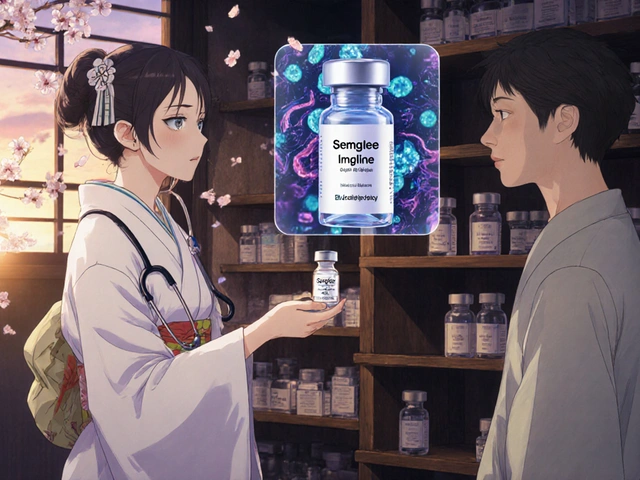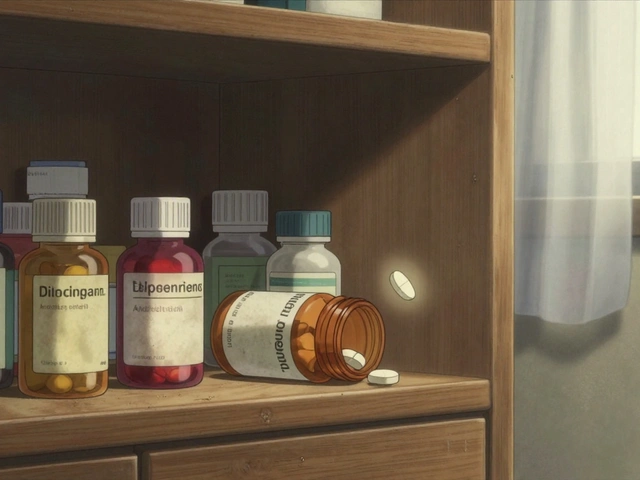When you pick up a prescription for insulin or an arthritis drug, you might not realize the pill you’re handed could be a biosimilar-and if it’s labeled as interchangeable, the pharmacist didn’t even need to ask your doctor. This isn’t science fiction. It’s happening right now in pharmacies across the U.S., and it’s changing how millions access life-saving treatments.
What Makes a Biosimilar Different From a Generic?
Think of generics as exact copies of small-molecule drugs like aspirin or metformin. They’re chemically identical to the original brand name. Biosimilars? They’re not copies. They’re highly similar versions of complex biologic drugs made from living cells-like Humira, Enbrel, or Lantus. These drugs are made in living systems (think yeast, bacteria, or animal cells), so even tiny changes in the manufacturing process can affect how they work. That’s why the FDA doesn’t call them "equivalent" like generics. Instead, they’re called "biosimilar," meaning they match the original in safety, purity, and potency-but aren’t identical.Interchangeability: The Extra Step
Not all biosimilars are created equal when it comes to substitution. Only those with the FDA’s "interchangeable" designation can be swapped out automatically at the pharmacy, just like a generic. To earn that label, a biosimilar must prove it can be switched back and forth with the original drug-multiple times-without increasing risk or reducing effectiveness. That means clinical studies where patients alternate between the reference product and the biosimilar. One study might involve switching three times: biologic → biosimilar → biologic → biosimilar. If the patient’s immune response, drug levels, and side effects stay stable throughout, the FDA may grant interchangeability. The first interchangeable biosimilar approved was Semglee, an insulin glargine product, in July 2021. Then in August 2023, Cyltezo became the first interchangeable monoclonal antibody biosimilar-targeting conditions like rheumatoid arthritis and psoriasis. As of November 2023, the FDA has approved 10 interchangeable biosimilars out of 41 total biosimilars.Why It Matters: Cost and Access
Biologics are expensive. Humira, for example, cost over $70,000 per year before biosimilars entered the market. Interchangeable biosimilars typically cost 15-30% less. That’s not just savings for patients-it’s billions saved for insurers and the healthcare system overall. A 2022 RAND Corporation study found biosimilars reduced spending significantly, especially when substitution was automatic. States with laws allowing pharmacists to swap without prescriber approval saw 18.7% higher biosimilar use for insulin, according to a 2023 JAMA Health Forum study. But here’s the catch: interchangeability doesn’t mean you can swap between two different biosimilars. If your doctor prescribed Cyltezo, and your pharmacy has Hadlima (another adalimumab biosimilar), they can’t automatically switch you to Hadlima-even if both are interchangeable with Humira. The FDA’s rules only allow substitution with the original reference product, not between biosimilars. That creates confusion for pharmacists and patients alike.
State Laws: A Patchwork of Rules
Federal rules say interchangeable biosimilars can be substituted automatically. But state laws decide if they actually are. As of 2023:- 40 states (including Arizona, California, and New York) allow pharmacists to substitute without asking the doctor.
- 6 states and Washington D.C. only allow substitution if it saves the patient money.
- 4 states (Alabama, Indiana, South Carolina, Washington) plus Puerto Rico require the doctor’s permission every time.
What Patients Experience
Some patients report no issues. One user on the Psoriasis Foundation forum said switching from Humira to Hyrimoz saved them $800 a month with no loss in symptom control. Others weren’t told at all-and had reactions. One person reported an allergic response after their pharmacy switched to Hadlima without notice. The problem? Biosimilars can have different inactive ingredients (excipients) than the original drug. While the active part is nearly identical, those extra chemicals can trigger allergies or side effects in rare cases. A 2022 National Psoriasis Foundation survey showed 63% of patients were satisfied with their biosimilar, but 28% were upset they weren’t informed. That’s a big deal. Informed consent matters. Even if the law doesn’t require it, ethical practice does. Some states, like Arizona, require pharmacists to notify patients in writing and send records to the prescriber within five days. Others don’t.Pharmacists Are Caught in the Middle
Pharmacists are expected to know federal rules, state laws, insurance policies, and product labels-all while managing busy counters. The American Pharmacists Association offers a 2.5-hour Biosimilars Certificate Program. As of October 2023, over 12,000 pharmacists had completed it. Still, a 2023 survey found pharmacists spent an average of 8.7 hours a year just keeping up with changing rules. Insurance companies make it harder. About 78% of commercial health plans require automatic substitution for interchangeable biosimilars when state law allows. That means if your plan covers Cyltezo and your state permits substitution, your pharmacy has to switch you-even if you’d prefer to stay on Humira. You can opt out, but you’ll likely pay more out of pocket.
The Big Debate: Should All Biosimilars Be Interchangeable?
There’s a growing push to eliminate the need for switching studies entirely. The Biosimilar Red Tape Elimination Act, introduced in late 2022, would make every FDA-approved biosimilar automatically interchangeable. Supporters say it would cut red tape and speed up savings. The Biosimilars Council backs it. But PhRMA, the big pharma lobby, argues it could risk patient safety. They point to studies showing non-medical switches (like swapping drugs without clinical reason) led to a 20.3% higher discontinuation rate in psoriasis patients, according to a 2021 JAMA Dermatology editorial. The FDA’s stance is clear: all approved biosimilars are safe and effective. Interchangeability isn’t about quality-it’s about substitution logistics. As Dr. Sarah Yim from the FDA put it in 2023: "Interchangeables are not a higher level of biosimilar. They’re just a different path to the same outcome."What This Means for You
If you’re on a biologic drug, here’s what you should know:- Your prescription might be switched to a biosimilar without you being told-unless you live in Alabama, Indiana, South Carolina, or Washington.
- Check your medication label. Interchangeable biosimilars will have the same name as the original, but end in a four-letter suffix (like adalimumab-adbm for Cyltezo).
- Ask your pharmacist: "Is this interchangeable?" and "Was this a substitution?"
- If you feel different after a switch-worse symptoms, new side effects-call your doctor immediately.
- You can always ask your doctor to write "dispense as written" or "do not substitute" on your prescription.
The Future: More Biosimilars, More Confusion?
By 2025, 70% of the top 20 biologic drugs by sales will have biosimilar competition. That means more interchangeable options coming-especially for insulin, rheumatoid arthritis, and cancer drugs. But without national standardization, the system will stay messy. Patients will get different experiences depending on where they live. Pharmacists will keep struggling to keep up. And the cost savings? They’re real-but only if the system works smoothly. Right now, the U.S. is the only country with a formal interchangeability designation. Europe, Canada, and Japan handle substitution differently-often requiring doctor approval. The U.S. model aims for speed and savings. But without better education, clearer rules, and consistent communication, it risks leaving patients and providers behind.Can a pharmacist substitute a biosimilar without telling me?
In 40 U.S. states and Washington D.C., yes-if the biosimilar has FDA interchangeability status and your state allows automatic substitution. In four states (Alabama, Indiana, South Carolina, Washington), the pharmacist must get your doctor’s approval first. Even where substitution is allowed, pharmacists aren’t always required to notify you. Always ask if your medication was switched.
Are interchangeable biosimilars safer or better than non-interchangeable ones?
No. All FDA-approved biosimilars-interchangeable or not-are held to the same strict standards for safety, purity, and potency. The interchangeability label only means the product has passed extra studies showing it can be switched back and forth with the original drug without increasing risk. It doesn’t mean it’s stronger or more effective.
Can I be switched from one biosimilar to another?
No. FDA rules only allow substitution from a reference biologic to an interchangeable biosimilar-not between two different biosimilars. So if you’re on Cyltezo (an interchangeable adalimumab biosimilar), your pharmacy can’t switch you to Hadlima (another adalimumab biosimilar) without your doctor’s approval, even if both are interchangeable with Humira.
Why do some biosimilars have four-letter endings?
Those four-letter suffixes are non-proprietary, assigned by the FDA to help track which product you’re taking. For example, Humira is adalimumab, and Cyltezo is adalimumab-adbm. This helps distinguish between the original and biosimilars, especially when reporting side effects or tracking safety data. It’s not a code for quality-it’s just an identifier.
How do I know if my insurance will cover a biosimilar?
Most commercial health plans require automatic substitution for interchangeable biosimilars when state law permits it. If you’re unsure, call your insurer or check your plan’s formulary. You can also ask your pharmacist to check whether the biosimilar is preferred on your plan. If you prefer the original drug, you can request it-but you may pay more out of pocket.








Michael Salmon
November 20, 2025 AT 04:45Let me get this straight - we’re giving pharmacists the power to swap life-saving drugs without telling patients? That’s not healthcare, that’s corporate roulette. And don’t give me that ‘cost savings’ nonsense - if you’re cutting corners on biologics, you’re gambling with people’s immune systems. I’ve seen patients crash after a switch. The FDA doesn’t care because Big Pharma’s paying for the study. Wake up.
Joe Durham
November 21, 2025 AT 23:31I get the concern, but I’ve been on a biosimilar for 18 months now - no issues. My rheumatoid arthritis is stable, and I’m saving $900/month. The key is communication. If your pharmacist tells you about the switch and your doctor monitors you, it’s fine. Not every swap is a disaster. Maybe the system just needs better education, not a ban.
Derron Vanderpoel
November 22, 2025 AT 15:16ok so i just got switched to some biosimilar and i thought i was getting the same thing but then i checked the bottle and it said adalimumab-adbm????? what even is that?? i thought humira was humira?? now i’m paranoid i’m gonna break out in hives at 3am and no one will know why bc no one told me. pls help. also my pharmacist just shrugged and said ‘it’s cheaper’ 🤡
Timothy Reed
November 24, 2025 AT 14:02The regulatory framework for biosimilars in the U.S. is fundamentally sound, but its implementation is fragmented. The disconnect between federal approval and state-level enforcement creates unnecessary risk. Standardizing notification protocols across all 50 states would mitigate patient confusion and improve compliance. Additionally, integrating biosimilar tracking into EHR systems would allow clinicians to monitor substitution events in real time - reducing adverse event reporting delays. The infrastructure exists; what’s lacking is coordinated policy execution.
Christopher K
November 26, 2025 AT 09:11Oh great, now we’re copying Europe’s ‘meh, it’s close enough’ system. First they take our jobs, then they take our medicine. I pay taxes so I can get the real drug, not some lab-grown knockoff with a four-letter suffix. If you want cheap, go to Mexico. This is America - we don’t settle for ‘good enough’ when it comes to our health. Screw the biosimilars. Send me the original or don’t give me anything.
harenee hanapi
November 27, 2025 AT 15:13OMG I CANT BELIEVE THIS IS HAPPENING I WAS SWITCHED TO A BIOSIMILAR AND I FELT LIKE I WAS DYING FOR TWO WEEKS AND NO ONE TOLD ME AND NOW MY DOCTOR THINKS I’M JUST STRESSED AND I’M SO ANGRY AND I JUST WANT TO SCREAM AND ALSO I’M NOT SURE IF I CAN TRUST ANYONE ANYMORE BECAUSE WHAT IF THEY SWITCH ME AGAIN AND I DIE AND NO ONE CARES??
Christopher Robinson
November 29, 2025 AT 04:05Just had my first switch to Semglee - no issues, saved me $700/month. 🙌 Pharmacist gave me a printed sheet explaining the switch, sent a note to my doc, and even answered my 17 questions. It’s not scary if you’re informed. The real problem? Most people don’t ask. Ask. Always ask. And if you’re nervous, say ‘dispense as written.’ Your doctor’s got your back. 💉❤️
James Ó Nuanáin
November 30, 2025 AT 21:41While the American model of automatic substitution is economically expedient, it lacks the cultural and regulatory coherence observed in the United Kingdom’s NHS framework, where substitution is contingent upon prescriber consent and patient notification. The absence of a unified national protocol undermines patient autonomy and constitutes a regulatory failure of the first order. Furthermore, the proliferation of four-letter suffixes, while scientifically defensible, introduces unnecessary nomenclatural complexity into an already convoluted system. One might argue that the United States prioritises cost-efficiency over clinical dignity.
Nick Lesieur
December 1, 2025 AT 06:18lol so now pharmacists are doctors? great. next they’ll be writing prescriptions for antidepressants and telling me what my ‘real’ diagnosis is. also the ‘interchangeable’ label is just a marketing trick. i’ve seen the data - the studies are 12 weeks long and use healthy volunteers. real patients? they’re not in the trials. also, why do i care if it’s cheaper if i’m allergic to the dye in the new one? someone’s gotta pay for this mess. it’s not me. it’s the guy who gets the rash and ends up in the er.
Angela Gutschwager
December 1, 2025 AT 07:42Ellen Calnan
December 1, 2025 AT 16:01It’s fascinating how we’ve turned healthcare into a logistics puzzle. We’ve got these incredibly complex, living-molecule drugs - products of years of biological engineering - and we’re treating them like interchangeable lightbulbs. But here’s the deeper question: if we’re so obsessed with cost-cutting, why aren’t we fixing the real problem? Why does a single vial of Humira cost $70,000 in the first place? The biosimilar system isn’t broken - it’s a bandage on a hemorrhage. We’re optimizing the wrong thing. The real innovation isn’t substitution. It’s rethinking how we value life-saving medicine in a capitalist system that treats patients like line items.
Chuck Coffer
December 2, 2025 AT 10:29Yeah sure, ‘it’s safe’ - until your kid’s autoimmune flare comes back because the pharmacist swapped it without telling you. And then you’re stuck paying $500 out of pocket to get the original back. Meanwhile, the insurance company laughs all the way to the bank. This isn’t progress. It’s exploitation dressed up as innovation. And the FDA? They’re just the corporate cheerleader with a lab coat.
Marjorie Antoniou
December 3, 2025 AT 22:24I work in a clinic. I’ve seen patients terrified after a switch - not because the drug didn’t work, but because they felt betrayed. No one asked them. No one explained. We need mandatory patient notification - not because the science is flawed, but because trust matters. You can save money without stealing someone’s sense of control over their own body. It’s not hard. Just tell them.